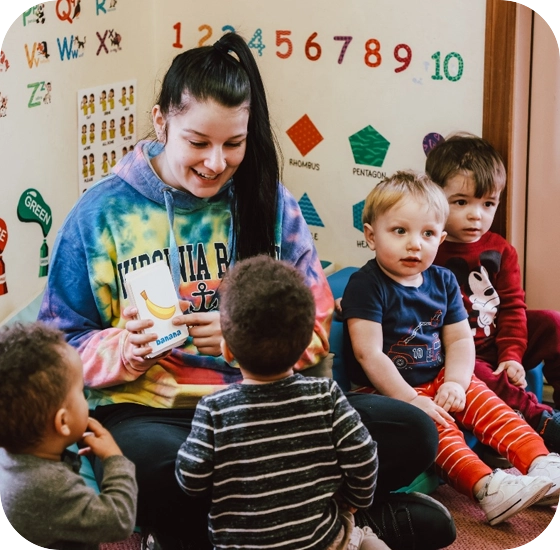Reading is a crucial skill that lays the foundation for a child’s academic and personal success. As such, early childhood education plays a vital role in fostering and nurturing a child’s reading abilities. Children’s brains undergo rapid development during early childhood, and they learn critical language and literacy skills.
Shared reading is an effective and valuable tool that parents, caregivers, and educators can employ to help children acquire the necessary skills to become proficient readers. Reading aloud to a child is a powerful way to enrich vocabulary, develop phonemic awareness, and enhance comprehension levels.
In this article, we will delve into the many other benefits that shared reading offers for early childhood education.
What is Shared Reading?
It is an incredibly effective way to introduce children to the joys of reading and help them develop the necessary skills for literacy success. It’s not just about reading the words out loud but also about engaging with the story and exploring the meaning behind the words. When a parent, caregiver, or teacher engages in shared reading with a child, they create a special bonding experience that can help strengthen their relationship and build a love for reading.
During shared reading, the adult can model different reading strategies, such as fluency, comprehension, and phonemic awareness. For example, they may point out specific words, ask questions about the story, or pause to let the child fill in a word or phrase. By doing so, they can help the child develop the necessary literacy skills and a deeper understanding of the story.
It’s important to note that shared reading should be an interactive reading experience. The child should be encouraged to participate by asking questions, making comments, or even predicting what might happen next in the story. This type of engagement can help the child develop critical thinking skills and improve comprehension.
Shared reading can be a fun and rewarding experience for both the child and the adult. By creating a positive association with reading, the child is more likely to continue reading on their own and develop a lifelong love for books.
The Importance of Shared Reading
To help children become successful readers, it is essential to develop and nurture their reading skills during their early childhood education. Luckily, shared reading is a powerful tool that can be used by parents, caregivers, and educators to achieve this goal. By engaging in shared reading, children acquire the necessary skills to become proficient readers. So, what are the benefits of this reading strategy? Let’s explore them.
Language Development
Shared reading is a great way to support a child’s language development. When a child listens to an adult reading, they are exposed to new words and language structures. This exposure to language helps to build a child’s vocabulary, grammar, and syntax. The child can also learn to recognize and use language patterns, which can help them to improve their oral language development.
Moreover, it can help children to understand how language works. They can learn about the different parts of a sentence, such as subjects and verbs, and how they fit together to create meaning. This knowledge can help children to improve their own language skills, such as writing and speaking.
Vocabulary Building
When a child is exposed to new words, they can learn their meanings and how to use them in context. This exposure to new words can help to expand a child’s vocabulary, which can have a positive impact on their academic and personal success.
This can also help them to understand the nuances of language. They can learn about synonyms, antonyms, and homonyms, which can help them to use language more effectively.
Phonemic Awareness
Phonemic awareness is the ability to hear and manipulate the sounds in language. This skill is essential for learning to read and write. Shared reading can help children to develop phonemic awareness by exposing them to the sounds of language in a fun and engaging way.
When an adult reads a story to a child, they can emphasize the sounds of different words. This emphasis can help children to hear the individual sounds in words, which can help them to develop their phonemic awareness skills. Moreover, shared reading can also help children to develop their letter-sound knowledge, which is essential for learning to read.
Comprehension Skills
When an adult reads a story to a child, they can ask questions about the story to check the child’s understanding. This process can help children to learn to identify the main idea of a story, make predictions, and draw conclusions.
Moreover, shared reading can also help children to develop their critical thinking skills. They can learn to evaluate the information presented in the story, make connections to their own experiences, and think creatively.
Social and Emotional Development
Last but not least, this can also positively impact a child’s social and emotional development. When an adult reads a story to a child, they can use the story to teach valuable lessons about empathy, kindness, and problem-solving. This exposure to social and emotional concepts can help children to develop their own social and emotional skills.
It can also provide a bonding experience between the adult and the child. When an adult reads a story to a child, they can share a special moment together. This bonding experience can help to build trust, respect, and a strong relationship between the adult and the child.
Tips for Successful Shared Reading
Shared reading isn’t just about reading the words on the page; it’s about creating a positive and enjoyable reading experience. To help you out, here are some tips to make the experience more effective.
Choosing Appropriate Books
Choosing the right book and other reading resources is crucial for a successful shared reading experience. You want to select a book that is appropriate for your child’s age and reading level, as well as one that is engaging and interesting. Look for books with colorful illustrations, engaging characters, and a storyline that your child can relate to. You can also choose books that relate to your child’s interests, such as books about animals, nature, or favorite hobbies.
Also, consider the length of the book. Young children have shorter attention spans, so it’s best to choose books that are short and sweet. You can gradually increase the length of the books as your child’s attention span develops. Additionally, consider the book’s language and vocabulary. Choose books that use simple language and introduce new vocabulary words in a fun and engaging way.
Making Reading Interactive
Shared reading should be an interactive experience that engages both the adult and the child. One way to do this is to encourage your child to participate in the reading experience. This can include asking your child to help turn the pages, point out pictures, or repeat certain words or phrases. You can also make the reading experience interactive by incorporating different voices and sound effects into the story. This can help your child understand the different characters and their emotions.
Another way to make reading interactive is to use props or manipulatives to bring the story to life. For example, if you’re reading a book about animals, you can use stuffed animals or toy figurines to represent the different animals in the story. This can help your child visualize the story and create a more engaging experience.
Encouraging Participation
Encouraging your child to participate in the shared reading experience is crucial for building literacy and comprehension skills. This can include asking your child questions about the story or the characters or encouraging your child to make predictions about what might happen next. You can also ask your child to retell the story in their own words or to make up their own story based on the characters in the book.
In addition, you can incorporate activities or crafts related to the story. For example, if you’re reading a book about gardening, you can plant a small garden with your child or make a craft that involves painting or drawing flowers. This can help your child connect the story to real-life experiences and create a deeper understanding of the concepts introduced in the book.
Asking Questions
Asking questions is an important part of the shared reading that can help build comprehension and critical thinking skills. You can ask your child simple questions about the story, such as “What happened at the beginning of the story?” or “Who was your favorite character?” You can also ask more complex questions that encourage your child to think deeper about the story, such as “Why do you think the character did that?” or “What do you think might happen if the story had a different ending?”
Asking questions can also help your child develop important vocabulary and language skills. For example, if you ask your child to describe a character or an object in the story, they will have to use descriptive language and vocabulary words to do so. This can help expand their language skills and improve their ability to express themselves.
In conclusion
Shared reading is a powerful tool that can help children develop their language, cognitive, and socio-emotional skills. By choosing appropriate books, making reading interactive, encouraging participation, and asking questions, parents, caregivers, and educators can create successfully shared reading experiences. Moreover, it helps children become fluent readers and fosters a love for books and reading that can last a lifetime. It is never too early to start shared reading, and the benefits can be immense. So, let us all grab a book and start reading together!







